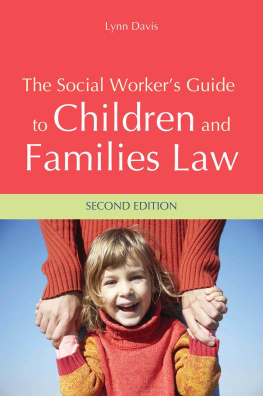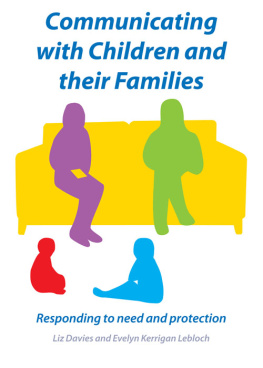The Social Workers
Guide to Children
and Families Law
by the same author
See You in Court
A Social Workers Guide to Presenting Evidence in Care Proceedings
Lynn Davis
ISBN 978 1 84310 547 3
eISBN 978 1 84642 656 8
A Practical Guide to Fostering Law
Fostering Regulations, Child Care Law and the Youth Justice System
Lynn Davis
Foreword by Christopher Simmonds
ISBN 978 1 84905 092 0
eISBN 978 0 85700 273 0
of related interest
Direct Work with Vulnerable Children
Playful Activities and Strategies for Communication
Audrey Tait and Helen Wosu
Foreword by Brigid Daniel
ISBN 978 1 84905 319 8
eISBN 978 0 85700 661 5
Vulnerable Children and the Law
International Evidence for Improving Child Welfare, Child Protection and Childrens Rights
Edited by Rosemary Sheehan, Helen Rhoades and Nicky Stanley
ISBN 978 1 84905 868 1
eISBN 978 0 85700 456 7
Mastering Whole Family Assessment in Social Work
Balancing the Needs of Children, Adults and Their Families
Fiona Mainstone
Part of the Mastering Social Work Skills series
ISBN 978 1 84905 240 5
eISBN 978 0 85700 484 0
Promoting Childrens Rights in Social Work and Social Care
A Guide to Participatory Practice
Margaret Bell
Part of the Children in Charge series
ISBN 978 1 84310 607 4
eISBN 978 0 85700 486 4
Team Parenting for Children in Foster Care
A Model for Integrated Therapeutic Care
Jeanette Caw with Judy Sebba
ISBN 978 1 84905 445 4
eISBN 978 0 85700 820 6
The Social Workers Guide
to Children and
Families Law
Lynn Davis
Jessica Kingsley Publishers
London and Philadelphia
This second edition first published in 2014
by Jessica Kingsley Publishers
73 Collier Street
London N1 9BE, UK
and
400 Market Street, Suite 400
Philadelphia, PA 19106, USA
www.jkp.com
Copyright Lynn Davis 2009, 2014
Front cover image source: iStockphoto. The cover image is for illustrative purposes only, and any person featuring is a model.
All rights reserved. No part of this publication may be reproduced in any material form (including photocopying or storing it in any medium by electronic means and whether or not transiently or incidentally to some other use of this publication) without the written permission of the copyright owner except in accordance with the provisions of the Copyright, Designs and Patents Act 1988 or under the terms of a licence issued by the Copyright Licensing Agency Ltd, Saffron House, 610 Kirby Street, London EC1N 8TS. Applications for the copyright owners written permission to reproduce any part of this publication should be addressed to the publisher.
Warning: The doing of an unauthorised act in relation to a copyright work may result in both a civil claim for damages and criminal prosecution.
Library of Congress Cataloging in Publication Data
Davis, Lynn, 1962- author.
The social workers guide to children and families law / Lynn Davis. -- Second Edition.
pages cm
Includes bibliographical references and index.
ISBN 978-1-84905-440-9
1. Children--Legal status, laws, etc.--England. 2. Parent and child (Law)--England. 3. Social workers--
England--Handbooks, manuals, etc. I. Title.
KD3305.D38 2014
346.42015--dc23
2013047020
British Library Cataloguing in Publication Data
A CIP catalogue record for this book is available from the British Library
ISBN 978 1 84905 440 9
eISBN 978 0 85700 814 5
Contents
Acknowledgements
I am grateful to my colleagues, clients, child care lawyers, social workers and foster carers for all they have taught me over the years.
I am indebted to my editor Steve Jones and the staff at Jessica Kingsley Publishers for their help in guiding me through the publishing process.
Thanks go to Mum, Mark and the pack for their support and encouragement.
This book is dedicated to my friends, especially Michelle, who actually reads my books!
Preface
This book is the product of my experience as a child care lawyer and trainer specialising in child care law since before the implementation of the Children Act 1989.
As for the first edition of this book, my aim is to make the essential principles of the law accessible and practical and I hope the book will be useful.
No book can be a substitute for legal advice on a particular case, but I hope that it will give readers an understanding of key legal issues and help them to ask their lawyers the right questions.
This second edition has been thoroughly revised to take account of many significant developments since the first edition and it is up to date as of April 2014. Law and practice in this area is evolving fast, so please be alert to the possibility of more changes since publication.
To avoid repetition of he/she I have chosen one gender or the other throughout.
The book discusses the law of England and Wales. At times I have referred simply to English law, but intend no disrespect to Welsh colleagues.
Any opinions expressed are entirely my own, and I take full responsibility for, and apologise for, any mistakes.
Introduction
We live in interesting times. There is a momentum for change, with reform of the family court system, streamlining of child protection procedures, increased court focus on human rights and a government drive to reduce delay in childrens cases and promote adoption, all in a challenging economic climate.
There is also a change in attitudes towards the social work profession. It is a moment of opportunity for social workers to step forward and claim their rightful role as expert professionals. For social work to become a confident, competent profession, practice must be based on sound foundations.
The law is the very bedrock of social work practice. A working knowledge of the key legal provisions is just as much a vital tool of the social workers trade as an understanding of attachment theory or anti-discriminatory practice.
The law defines your role as a social worker. It empowers you to protect children and promote their welfare, and it defines the limits of your powers and the boundaries of your duties, striking the balance between state power and individual freedom. The law confers rights and responsibilities, powers and duties.
Embrace the law as part of your core knowledge base. Ensure that you understand the fundamental principles so you can apply them to your case work, identifying legal issues and asking the right questions.
This book aims to build your knowledge step by step, to help you to understand the key provisions and to enable you to use the law to enhance your practice.
Chapter 1
Human Rights
Why start here? Quite simply, because every All the remaining chapters of the book must be read with this one in mind.
What are human rights?
There are many definitions of human rights but, for our purposes, the term human rights means those contained in the European Convention on Human Rights and Fundamental Freedoms 1950 (the Convention) because those are the rights incorporated into UK law by the HRA. The Convention is not linked to the European Union, membership being much wider.







![Heitritter Lynn - Helping victims of sexual abuse: [a sensitive biblical guide for counselors, victims, and families]](/uploads/posts/book/212530/thumbs/heitritter-lynn-helping-victims-of-sexual-abuse.jpg)
